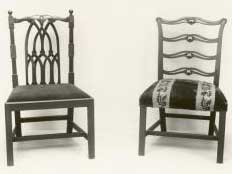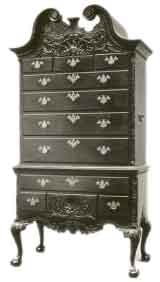American Chippendale Furniture
In the rococo period of furniture design in the 18th century it was the work of Thomas Chippendale, specifically his Gentleman and Cabinet Maker's Director, that had an almost exclusive sway over fashions in furnishings in America. The designs of Chippendale, a pared down, Anglicised, version of French rococo Louis XV furniture, were quickly taken up and the old Queen Anne style faded into antique history. The distinguishing characteristic of American Chippendale, as opposed to the English, was more emphasis on symmetry of line and proportion.

American Chippendale Chairs.
American Chippendale furniture designs were quite original and a number of new forms developed. Breakfront bookcases, kneehole chests of drawers, serpentine back sofas, kettle stands, and drop-leaf Pembroke tables. (See pictures of the original drawings.
Philadelphia
Perhaps America's most significant contribution to world furniture design in the antique period originated in the works of the Philadelphia manufacturerers and designers, like William Savery, who adapted Chippendale designs in a free style, creating expertly crafted and attractive furniture.
Chippendale Highboys
Chippendale style highboys are the major highlight of this work, richly decorated and carved with shells, vines, and tendrils in both the upper and lower halves, and often matched with lowboys of similar nature. Leaving English accomplishments in this area far behind, highboys in America were wildly popular right up until the Boston Tea Party.

Antique Chippendale Highboy, by William Savery.
Newport
The other great center of American furniture making at this time was Newport, especially in the creations of John Goddard and John Townsend. These designers utilised block and shell carving, that was almost the rival of the Philadelphia makers in its exquisite detail. The block front design was especially used in kneehole desks, desks with flat tops and recessed centres, flanked on either side by drawers.

Chippendale Chaise Lounge.
The Chippendale style held sway over American until the 1770s when English styles fell out of favour, to be replaced by French ones, in the period of Federal furniture.
